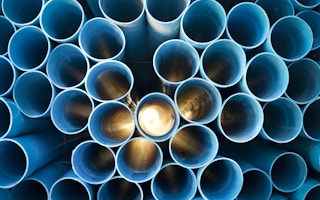Polyvinyl Chloride (PVC) is well documented to be a toxic substance, from the gasses released in the production process and finished product, to the lethal toxicity of PVC when it burns. It is banned in children’s toys and food packaging in most western countries and many of these countries are phasing out the use of PVC in the building industry. Australia has yet to address any of these areas and PVC can still be found in toys on sale in Australia, as well in building components such as pipes, wires and cable insulation, and flooring.
To continue reading, subscribe to Eco‑Business.
There's something for everyone. We offer a range of subscription plans.
- Access our stories and receive our Insights Weekly newsletter with the free EB Member plan.
- Unlock unlimited access to our content and archive with EB Circle.
- Publish your content with EB Premium.
As the Green Building Council of Australia (GBCA) embarks on a review of points awarded for the life cycle impact of PVCs, there is a real opportunity to drive a phase-out of PVC in the building industry.
Currently the GBCA aims to “reduce the environmental and health impacts of Polyvinyl Chloride (PVC) by encouraging the use of PVC material which adheres to best practice guidelines “in areas such as water consumption and emissions reduction. As the GBCA reviews the credits awarded for PVC use, it should also review the environmental effects of the production process and assess the public safety issues that are raised in the use of PVC products, particularly in high-risk public spaces.
Pipes, wires, flooring and other building products made from PVC are regularly used in schools, airports, hospitals, cinemas, underground railway tunnels and motorway tunnels, where public safety should be of primary concern. In the event of a fire, moving people out of these congested spaces is time-consuming and every effort should be made to ensure that additional hazards, such as exposure to toxic chemicals, are avoided. Yet there are no regulations in place to ensure this basic safety standard is met.
“
Pipes, wires, flooring and other building products made from PVC are regularly used in schools, airports, hospitals, cinemas, underground railway tunnels and motorway tunnels, where public safety should be of primary concern. In the event of a fire, moving people out of these congested spaces is time-consuming and every effort should be made to ensure that additional hazards, such as exposure to toxic chemicals, are avoided.
A report by the US Green Building Council has made clear that, across its lifecycle, PVC leads to dangerous levels of dioxins and other carcinogens. It concludes that, “When we add end of life with accidental landfill fires and backyard burning, the additional risk of dioxin emissions puts PVC consistently among the worst materials for human health impacts…”
Recently, there has been a trend in removing phthalate plasticisers, which are used to make PVC soft and pliable, from vinyl products and labelling them as ‘green’. While removal of these plasticisers is a good thing, the modifications do not address the fundamental problem of the vinyl itself; chlorine chemistry. Chlorine chemistry forms toxic by-products from production to disposal. The Healthy Building Network recently conducted a study of replacement plasticisers in PVC and still stressed that “due to its overall human health and environmental impacts from manufacturing to disposal, PVC should be a choice of last resort in the selection of building materials.”
For the same reasons, another ‘green’ initiative that involves replacing the petroleum in PVC with renewable carbon does not green its lifecycle nor make the product any less toxic. Neither does recycling PVC.
Corporations, associations and industries the world over have rallied together to show their support for PVC phase-out, with Apple being the latest advocate to successfully remove PVC in all of its products. Spain has over 60 PVC free cities. Slovakia has banned all PVC products. More than 100 healthcare institutions worldwide are reducing or phasing out PVC and phthalates. The entire European Union has banned phthalates in children’s toys. The American Public Health Association (APHA) has called for a complete chlorine phase-out. The International Association of Firefighters has stated that: “Due to the intrinsic hazards, we support efforts to identify and use alternative building materials that do not pose as much risk as PVC to firefighters, building occupants or communities.”
On the 24 July last year, the Center for Biological Diversity filed a legal petition urging the U.S. Environmental Protection Agency (EPA) to protect people, wildlife and the environment from toxic and carcinogenic chemicals found in PVC. If successful, PVC will be classified as hazardous waste, resulting in tighter regulations for disposal and, ultimately, a reduction in the amount of toxic chemical additives. Center attorney Emily Jeffries stated:
“PVC plastic is one of the most hazardous consumer products ever created, but once we’re through with it, it can be thrown away just like food scraps or grass clippings… The problem is that some of the very chemicals that make PVC so durable for our use have the potential to poison people and wildlife, especially if it finds its way into the ocean and starts to break down. It’s time for EPA to do its job”.
The Living Building Challenge certification programme has recognised the environmental and health issues with PVC and entirely prohibits the use of PVC in any of its certified projects. Banning PVC use in high-risk public spaces and ultimately phasing it out in the building industry are the first and most glaringly obvious public safety steps. Improving best practice guidelines for GBCA’s PVC credit would go some way towards improving safety standards in new builds and refurbishments in Australia and offering a credit for non-PVC use would be a positive step towards achieving this. In addition, a regulatory stance is required to ensure that this key public safety issue is addressed.
Sarah-Jane is the CEO of Communicate Blue and NSW Lead of Blue Economy consultancy, Blue Australasia. This post was written exclusively for Eco-Business.









